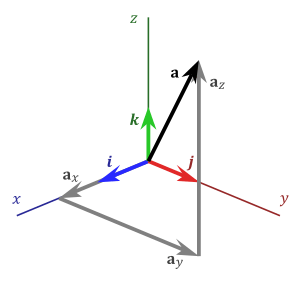Versor (physics)

In geometry and physics, the versor of an axis or of a vector is a unit vector indicating its direction.
The versor of a Cartesian axis is also known as a standard basis vector. The versor of a vector is also known as a normalized vector.
Versors of a Cartesian coordinate system
The versors of the axes of a Cartesian coordinate system are the unit vectors codirectional with the axes of that system. Every Euclidean vector a in a n-dimensional Euclidean space (Rn) can be represented as a linear combination of the n versors of the corresponding Cartesian coordinate system. For instance, in a three-dimensional space (R3), there are three versors:
They indicate the direction of the Cartesian axes x, y, and z, respectively. In terms of these, any vector a can be represented as
where ax, ay, az are called the vector components (or vector projections) of a on the Cartesian axes x, y, and z (see figure), while ax, ay, az are the respective scalar components (or scalar projections).
In linear algebra, the set formed by these n versors is typically referred to as the standard basis of the corresponding Euclidean space, and each of them is commonly called a standard basis vector.
Notation
A hat above the symbol of a versor is sometimes used to emphasize its status as a unit vector (e.g., ).
In most contexts it can be assumed that i, j, and k, (or and ) are versors of a 3-D Cartesian coordinate system. The notations , , , or , with or without hat, are also used, particularly in contexts where i, j, k might lead to confusion with another quantity. This is recommended, for instance, when index symbols such as i, j, k are used to identify an element of a set of variables.
Versor of a non-zero vector
The versor (or normalized vector) of a non-zero vector is the unit vector codirectional with :
where is the norm (or length) of .